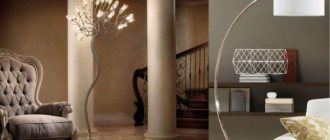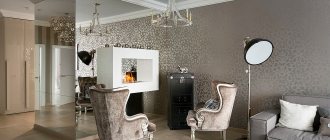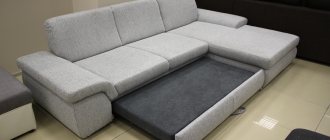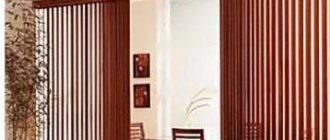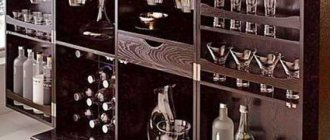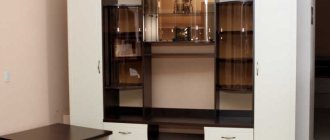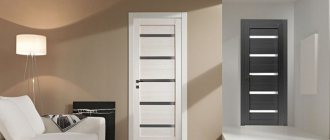Light flow
The first question that arises when we choose a lamp is: how suitable it is for our specific needs, how much light it will give. We are used to equating the amount of light, or luminous flux, with the power of the lamp - how much energy it consumes. This is wrong, about the same as measuring the quality of gasoline by the speedometer. Watt is a measure of the amount of electricity a lamp consumes and depends on the luminous flux and the type of lamp. Luminous flux is measured in lumens (Lm/Lm); To understand how much light a light bulb will give, you need to look at this indicator.
For example, if a chandelier contains 12 LED lamps of 5 watts each, this will give a total of 60 watts, which is equal to one incandescent lamp of the same 60 watts. However, one 5-watt LED bulb produces 460 lumens, and one 60-watt incandescent bulb produces approximately 660 lumens. To compare power (watts) and luminous flux (lumens) of different lamps, you can use power tables for simplicity.
Too strong a luminous flux, that is, very bright light that is unpleasant for the eye, can cause a blinding effect. It is important to take this into account and leave the amount of light in the room that is comfortable for you. If a designer is working with an apartment, he should calculate the optimal light based on your needs, and not select a chandelier only by design. In order to save energy, it is often recommended to install a dimmer - a device that allows you to adjust the brightness of the light. In fact, this does not provide any savings: your light may be dimmed, but in fact the light bulb consistently consumes the same amount of energy. This means that the difference in electricity consumption will be insignificant - at best, 3-4% less, which in terms of money will not provide tangible savings.
What should be the power of the lamp depending on the room?
The required level of illumination depends, first of all, on the room it is intended for, since the corridor and kitchen require different amounts of light. Here it is also worth mentioning such factors as the height of the ceilings, the size of the room, and the dominant color in the interior.
In addition, it is necessary to take into account what role the lamp should play in the light composition, whether it will organize task lighting or additional decorative lighting.
The table shows average power standards in accordance with a ceiling height of no more than 3 m.
| Room name | Required power |
| Bedroom | 12-14 W per 1 sq.m. |
| Pantry, glazed balcony/loggia | 10-12 W per 1 sq.m |
| Corridor | 10 W per 1 sq.m |
| Bathroom | 14-16 W per 1 sq.m. |
| Children's | 15-18 W per 1 sq.m. |
| Kitchen | 15-18 W per 1 sq.m. |
| Living room | 20 W per 1 sq.m. |
| Study | 20 W per 1 sq.m. |
Light temperature
The second important characteristic on the packaging - the temperature of the light - is most often indicated not only by a number, but also by words that are understandable to the average person: “warm”, “cold”, “daylight” light and so on. Cold light gives you vigor, and warm light gives you relaxation. The temperature of light is measured in Kelvin (K) and can range from 2,700 to 6,000 K. The higher the number, the cooler the light: 4,000 K is neutral light, and 6,000 K is cool daylight white.
The range from 2,700 to 3,000 K is considered optimal for a residential interior in our latitudes - this is a warm white color. At the same time, “cool” lamps (4,500–5,000 K) are in demand in the southern regions: due to the visual impression, the body is adjusted to the fact that such a room is light and cool.
It is important to ensure that in the same room being viewed, the light is turned on at approximately the same temperature at the same time. The “rainbow” of different temperatures forces the eye to constantly readjust, which makes you tired by the end of the day. For different purposes, there may be several levels of lighting, which are turned on in turn: you are having a party or you want to put your child to sleep - its functional purpose depends on the level of light.
Features of LEDs
Light diodes are special lamps in which alternating current is transformed into direct current. The light intensity is determined by the voltage. The higher the voltage, the higher the lighting power. Diode technology ensures economical energy consumption.
Another feature of diodes is a wide range of light bulbs. Chandeliers use a variety of bases. Each of them corresponds to a specific type of light bulb.
The power classification of LEDs also has its own characteristics. For example, a regular 90-100 W incandescent light bulb corresponds to a 9-15 W LED device. The difference in power with the same glow intensity obviously leads to energy savings.
The glow emitted by LEDs comes in several types:
- Warm. Yellow color.
- Quiet, where the color is approximately equal to daylight.
- Cold, expressed in the white color of the light flux.
One of the qualities for which consumers value LED sources is their long service life. Conventional incandescent lamps last much less than light diodes. Therefore, despite higher prices, LEDs are considered economical.
The widest range offered by manufacturers allows you to choose a light bulb to suit every taste. For example, for crystal chandeliers, small ones that emit a cold glow are recommended.
Color rendering index
The third parameter describes how colors are perceived under artificial light, because light can distort them. This is important not only for the designer’s work with color, but also in order to accurately see the color of clothing and makeup in the mirror. For example, if you have lamps with distorted color rendering, then a blouse that was burgundy in the store will turn out to be red-scarlet at home, or blondes will have a greenish tint in their hair.
The color rendering index can be specified in two ways: Ra and CRI (color rendering index). The number in this case is a percentage: so, 100% is the sun, and lamps are now capable of a maximum of 95%. For correct color rendering, the optimal value is at least 80 Ra/CRI. Unfortunately, Chinese manufacturers may indicate this data incorrectly, so if you don’t want to make a mistake, it is better to use lamps from well-known brands. If this index is not on the packaging, this clearly indicates an unreliable manufacturer - you can buy a pig in a poke.
Halogen lamps
Such products have fairly high efficiency and are much more durable than conventional incandescent lamps, although they are their modification. They differ from conventional incandescent lamps in that the bulb contains halogen gas, which extends the life of the lamp. Halogen lamps have higher color output. The disadvantages include increased heating, which can cause fires, toxicity, and the lamps require certain handling - you should not touch the glass with your fingers, this will cause the lamp to burn out instantly.
Lampshade effect
When choosing a lamp, consider what kind of lampshade you have, what material it is made of, that is, how transparent it is, and what color. After all, a lampshade is a filter. For example, if there is a 2,700K lamp in a yellow lampshade, you will get an overly warm light. For crystal or transparent chandeliers and lamps, it makes sense to choose only transparent lamps, because the essence of their decor is the play of rays of light, and a frosted lamp does not produce direct rays. But for an almost invisible lampshade, a matte lamp is suitable - it will intelligently diffuse the light and remove the effects of glare in places where the lamp is visible.
Scattering angle
Due to the design features of the lamp, different models may diffuse light differently. In order to form the required direction, various auxiliary optics are often used (matte polycarbonate bulbs, focusing/scattering lenses, etc.).
The angle of illumination of objects really plays a significant role in the feeling of comfort in a room. The higher it is, the larger the area your lamp will be able to illuminate. This indicator is standardized at the official level for various types of activities. For example, a workplace should be illuminated no less than 27°, and a large room should be illuminated no less than 120-130°.
But not all types of lamps are able to provide the required values. The same halogens are limited to 32-38°, which will automatically require the installation of a large number of lamps within one room for overhead lighting. At the same time, the range of operation of LED lamps is much wider. Their range is divided into several parts. Some models are great for directional light and are installed in the makeup area, near the workplace or computer. Others are suitable for illuminating spacious rooms. Among them there are lamps with a lighting angle of over 270°, which allows the most daring ideas of designers to be realized when designing an interior.
In LED lamps, manufacturers can specifically position the diodes so that they emit light in different directions. The leading role in this regard is played by the technology of the light bulb: SMD or filament. For the first type, the determining criterion will be the direction of the LED. It emits a luminous flux solely depending on it, and is not able to cover large spaces. At the same time, according to filament technology, the emitting element is a sandwich consisting of a substrate, LEDs and a phosphor fill. Since the light emitted by the source will in any case reach the phosphor, the limitations associated with the scattering angle are not important for this type of light bulb.
As a technical indicator, the scattering angle value indicates the range in which at least 50% of the maximum amount of light emitted by the lamp is present. Some companies provide a simplified diagram with a visual representation of the direction of the light flux directly on the packaging of their products. The classification of such diagrams is presented in GOSTs: the traditional one is divided into 7 types, but with in-depth study it is much more extensive.
When properly designing indoor lighting, it is the dispersion angle that serves as the key zoning factor:
- to illuminate individual objects or small spaces, light sources with an angle of 30° or 60° are used;
- for overhead light of uniform saturation in large rooms - lamps with a wide angle - 140°, 160° or 180°;
- To solve individual lighting problems, lighting devices with different suspension heights can be used.
It should be noted that the selection of a light bulb for it will also depend on the design of the lamp itself. If you have a lampshade of complex shape, with overlap areas or made of dense material, part of the light flux will inevitably be lost. In addition, the very direction of the lampshade orients the luminous flux, and its elongated shape can slightly narrow the illuminated range. In each specific case, it is necessary to analyze such nuances and select a light bulb taking into account as much information as possible about the lamp, as well as the illumination required for a given zone.
Safety regulations
The power of the lamp must be correlated with the capabilities of the lamp.
This threshold is usually written on the sockets; it cannot be exceeded, otherwise the lamp may “leak” and the lampshade may melt or even catch fire due to a short circuit. There is also an indicator of the moisture protection of the lamp: the usual degree of protection is indicated by the abbreviation IP 20, for baths you need lamps marked from IP 44 to IP 55, the highest is IP 68.
When installing, it is critical to calculate how much weight the chandelier will support the ceiling mount.
Lamps also have an indicator of the amount of current they conduct - these are volts (V/V). A level of 12 or 24 volts is safe for humans, but 220 volts is already fraught with consequences, especially in the bathroom.
It is important to consider that gas-discharge and fluorescent lamps are not recommended in residential interiors, and halogen lamps get very hot.
What styles are there floor lamps?
Classical
Floor lamps with a simple and strict design. Lampshades are made of paper, plastic or fabric. Color palette: shades of cream, milky, beige, green. In a classic interior style, the main lighting is created by a massive chandelier, while the functions of a floor lamp are auxiliary and decorative.
Modern
Art Nouveau floor lamps are a combination of smooth lines, calm colors with metallic shades and minimalist design. Lampshades are most often matte, spherical or cone-shaped.
High tech
The main features of high-tech style lamps are functionality, minimalistic design, an abundance of metal, and strict geometry of the elements. Lampshades can be metal, glass (frosted glass), or less often plastic. Powerful LEDs or halogen lamps are used as light sources. High-tech style models are suitable for lofts and apartments in an urban style.
Country
Country style floor lamps feature a predominance of natural materials, soft diffused lighting, and calm warm shades of a light palette. Lampshades made from natural materials with simple prints or checkered patterns. Wooden racks can be decorated with carvings.
Scandinavian
A style close to eco-design and minimalism. The distinctive features of floor lamps in the Scandinavian style are simplicity, functionality, bright lighting, the predominance of light shades and natural materials.
Retro
Retro floor lamps are forged, stained glass, tassels, fringe. Lampshades made of glass or fabric. The style stands out with bright, rich colors.
Minimalism
Floor lamps in the minimalist style are simple geometric shapes, long straight or arched stands, plain colors, lampshades without a pattern in white, black or gray.
Techno
The main features are a minimum of decorative elements, functionality and practicality (massive stands, adjustable tripods, rotating lampshades). Primary colors – metallic, silver, chrome. Lampshades made of metal, clear or frosted glass.
Eco style
The design is dominated by natural materials and natural colors of warm shades. Floor lamp stands are most often made of wood, lampshades are made of cotton, jute, linen textiles.
Tiffany
The lampshades of Tiffany-style floor lamps have a complex “stained glass” pattern and are made primarily of glass. The material of the stands is metal, wood. The color scheme is dominated by golden and beige shades or more contrasting colors.
Purchase in store
Before you go to the store, find the most comfortable lighting in your home that you want to use as a starting point. Unscrew the lamp and use its indicators to create a recipe for your light: see which characteristics suit you and which do not, and how much you want to improve them. For example, you like the color of the light, but want the brightness to be 30% more, which means the lumens should be 30% higher.
Next, with this cheat sheet, go to the store and see what lamps are available. It is better not to count on the help of the seller; he is unlikely to tell you more than what is written on the box, with the exception of the quality of the brand as a whole. If in doubt, you can agree with the manager or seller that you will make a test purchase and try the lamps at home, and return those that are not suitable.
When you experiment at home, do not forget that light affects the appearance of the interior. Take a table lamp, screw in different light bulbs and watch how your perception of the colors and textures of walls and furniture changes. The same can be done with lamps: many stores give them for trying on as a deposit.
Photos: cover – 8meg – adobe.stock.com, 1 – anyanuchoil – adobe.stock.com, 2 – eyalg_115 – adobe.stock.com, 3 – Alex – adobe.stock.com
Auxiliary criteria
Ceiling lamp
If you are used to using an intricate lampshade or a carved lampshade, think about what percentage of light distortion they will introduce: both in the color of the glow and in the illumination. One way or another, in this context the lampshade acts as an optical filter. The overall appearance of the room depends on whether it is matte, transparent or colored. Depending on whether the lampshade is single or multi-colored - there is a rainbow on the walls. Finally, the material itself from which it is made sets the overall tone of the interior.
Let's imagine that a light bulb with warm light, level 2700 K in color temperature, is installed in a traditional dark beige or yellow lampshade. In this case, the room will be flooded with a “concentrated” warm glow, causing suffocation rather than pleasant warmth. You especially shouldn’t take such risks in the country house or in the kitchen. Unpleasant sensations are guaranteed for you.
A classic crystal chandelier or simply a transparent lamp harmonizes best with transparent light bulbs. The whole point of such lighting devices is precisely in the play of light, and if you put a matte lamp there, the entire desired effect will be lost.
At the same time, a coated light bulb will fit under the matte lampshade. It will immediately scatter the light and will never blind a person in those places where the lampshade itself should be visible through.
Let's not devote too much time to lamps for other places in the apartment. We believe that the basic principle is clear - the light bulb and the lamp must be combined with each other and not cause either aesthetic or physical discomfort to a person.
Base
It’s a little funny to dwell on this criterion, but often buyers take light bulbs from the shelves after reading all the main characteristics and completely forgetting about the type of base. It is all the more interesting that such consumers know exactly the desired color temperature, the required luminous flux, checked the color rendering index in advance, and also inquired about other products from the same manufacturer as the selected product. And only when checking the light bulb at the checkout it turns out that you should have taken the exact same lamp from the nearby rack, but with a different base.
Therefore, let us remind you: the most common base in our country is E27. The overwhelming majority of light bulbs use it. This standard threaded connection is one of the simplest and most reliable at the same time.
In second place is the so-called “minion”, or E14. The socket for it is often installed in sconces and small lamps. However, sometimes the latter type can be found in ordinary ceiling chandeliers. Here it is used to add additional lightness and elegance to the structure.
Sometimes you come across lamps with very small base diameters (E5, E10, E12) or, conversely, larger ones (E40), which are not used in everyday life and are used exclusively for street lighting. However, their scope of application is extremely limited and the consumer is unlikely to be deceived when choosing a light bulb for them.
From time to time, in European-made chandeliers you can also see sockets for a pin base. It is absolutely impossible to forget that you have a pin rather than a threaded connection, but it is quite possible to be deceived by their diversity, even though the choice of lamps for such sockets is significantly smaller (the main ones are , , GU5.3). Sometimes, if you really like a chandelier, it makes sense to even replace the original socket with a more common one and never have to worry about searching for specific light bulbs in the future.
Price
No one has canceled the price factor, but every prudent owner understands: a quality item cannot be too cheap. It’s better to buy a good light bulb once, and then forget about the need to replace it for five to seven years.
We are mainly talking, of course, about modern LED lamps from well-known global manufacturers. If we talk about the long-term perspective of using different types of light bulbs, this type will show the greatest savings, and the usual and beloved incandescent light bulbs will show the greatest wastefulness in relation to your family budget.
Types of LED light sources
Types of LED lamp bases
LED lamps are divided into several groups - according to intensity, base type and other characteristics.
Intensity compared to incandescent lamps:
- The 25-watt incandescent lamp is replaced by one 5.5-watt LED;
- 40 V – 8 W;
- 70-90 W – 15.
The most important characteristic of any light bulb is the base. LED products have the following types:
- pin G9;
- standard E27;
- E14.
- G4 for small light bulbs used in lighting;
- GU10 for spotlights;
- GU5.3 for chandeliers.
The most common bases are E27 and E14. They are similar, but with different thread diameters.
Service life and replacement
LEDs in the chandelier have a long service life. Upon purchase, a product warranty of 3 to 5 years is provided. The actual period of operation can reach 15 years. Such a long operating time justifies the high price of the devices.
LED light bulbs in a chandelier are easy to insert into the socket. But there are situations when the device continues to light or flash after a power outage. In this case, you should check the quality of the connection. The light bulb is removed from the socket, the contact area is cleaned, and then the device is put in place. If the situation does not improve, you need to seek help from an electrician or replace the device under warranty.
Types of lamps
A huge number of species differ in their design, method of power supply and type of lighting source. In addition to unusual decor, such lamps are multifunctional and sometimes have a built-in clock, which is very practical.
In terms of functionality, lamps with lampshades in the interior can be: working (with bright lighting) and decorative (diffused light).
Based on their designs, table lamps are divided into:
- classic with traditional design;
- exclusive with non-standard decor, shape and color.
In different designs, the dimensions of the lampshade may differ (height, depth, width), and the base may be different. In addition to traditional heating bulbs, there are sensor, halogen, LED or fluorescent lighting sources.
The need for lighting depends on the area of activity. For drawings or drawings, powerful lamps of 100 W or more are required; for other activities, 60 W is enough. Some models may have 2 or more bulbs inside the shade.
Incandescent lamp: design, application and connection features (85 photos)Dimmable LED lamps: detailed description of the device, selection and tips for using dimmable LED lamps
- Hanging chandeliers - an overview of popular options. Installation and connection instructions (video + photo)
A table lamp made of transparent materials will provide more light. With a translucent lampshade, the light is more diffused.
Examples of design ideas in photos of lamps with lampshades, made in different styles.
How to choose the size for a lampshade?
Let's figure out how to make a lampshade with your own hands. To do this, you first need:
- measure the upper and lower diameter of the future lampshade;
- choose its height;
- measure the height of the leg on which the lampshade will be placed.
